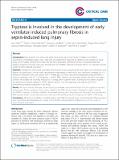| dc.contributor.author | Villar, Jesús | en_US |
| dc.contributor.author | Cabrera-Benítez, Nuria E | en_US |
| dc.contributor.author | Valladares, Francisco | en_US |
| dc.contributor.author | García-Hernández, Sonia | en_US |
| dc.contributor.author | Ramos-Nuez, Ángela | en_US |
| dc.contributor.author | Martín-Barrasa, José Luís | en_US |
| dc.contributor.author | Muros, Mercedes | en_US |
| dc.contributor.author | Kacmarek, Robert M | en_US |
| dc.contributor.author | Slutsky, Arthur S | en_US |
| dc.date.accessioned | 2015-05-04T15:27:32Z | |
| dc.date.issued | 2015 | en_US |
| dc.identifier.citation | Villar, Jesús, Nuria E Cabrera-Benítez, Francisco Valladares, Sonia García-Hernández, Ángela Ramos-Nuez, José Luís Martín-Barrasa, Mercedes Muros, Robert M Kacmarek, and Arthur S Slutsky. 2015. “Tryptase is involved in the development of early ventilator-induced pulmonary fibrosis in sepsis-induced lung injury.” Critical Care 19 (1): 138. doi:10.1186/s13054-015-0878-9. http://dx.doi.org/10.1186/s13054-015-0878-9. | en |
| dc.identifier.issn | 1364-8535 | en |
| dc.identifier.uri | http://nrs.harvard.edu/urn-3:HUL.InstRepos:15034951 | |
| dc.description.abstract | Introduction: Most patients with sepsis and acute lung injury require mechanical ventilation to improve oxygenation and facilitate organ repair. Mast cells are important in response to infection and resolution of tissue injury. Since tryptase secreted from mast cells has been associated with tissue fibrosis, we hypothesized that tryptase would be involved in the early development of ventilator-induced pulmonary fibrosis in a clinically relevant model of sepsis-induced lung injury. Methods: Prospective, randomized, controlled animal study using Sprague-Dawley rats. Sepsis was induced by cecal ligation and perforation. Animals were randomized to spontaneous breathing or two ventilatory strategies for 4 h: protective ventilation with tidal volume (VT) = 6 ml/kg plus 10 cmH2O positive end-expiratory pressure (PEEP) or injurious ventilation with VT = 20 ml/kg plus 2 cmH2O PEEP. Healthy, non-ventilated animals served as non-septic controls. We studied the following end points: histology, serum cytokine levels, hydroxyproline content, tryptase and proteinase-activated receptor-2 (PAR-2) protein level in lung homogenates, and tryptase and PAR-2 immunohistochemical localization in the lungs. Results: All septic animals developed acute lung injury. Animals ventilated with high VT had a significant increase of pulmonary fibrosis, hydroxyproline content, tryptase and PAR-2 protein levels compared to septic controls (P <0.0001). However, protective ventilation attenuated sepsis-induced lung injury and decreased lung tryptase and PAR-2 protein levels. Immunohistochemical staining confirmed the presence of tryptase and PAR-2 in the lungs. Conclusions: Mechanical ventilation modified tryptase and PAR-2 in injured lungs. Increased levels of these proteins were associated with development of sepsis and ventilator-induced pulmonary fibrosis early in the course of sepsis-induced lung injury. | en |
| dc.language.iso | en_US | en |
| dc.publisher | BioMed Central | en |
| dc.relation.isversionof | doi:10.1186/s13054-015-0878-9 | en |
| dc.relation.hasversion | http://www.ncbi.nlm.nih.gov/pmc/articles/PMC4391146/pdf/ | en |
| dash.license | LAA | en_US |
| dc.title | Tryptase is involved in the development of early ventilator-induced pulmonary fibrosis in sepsis-induced lung injury | en |
| dc.type | Journal Article | en_US |
| dc.description.version | Version of Record | en |
| dc.relation.journal | Critical Care | en |
| dash.depositing.author | Kacmarek, Robert M | en_US |
| dc.date.available | 2015-05-04T15:27:32Z | |
| dc.identifier.doi | 10.1186/s13054-015-0878-9 | * |
| dash.contributor.affiliated | Kacmarek, Robert | |


